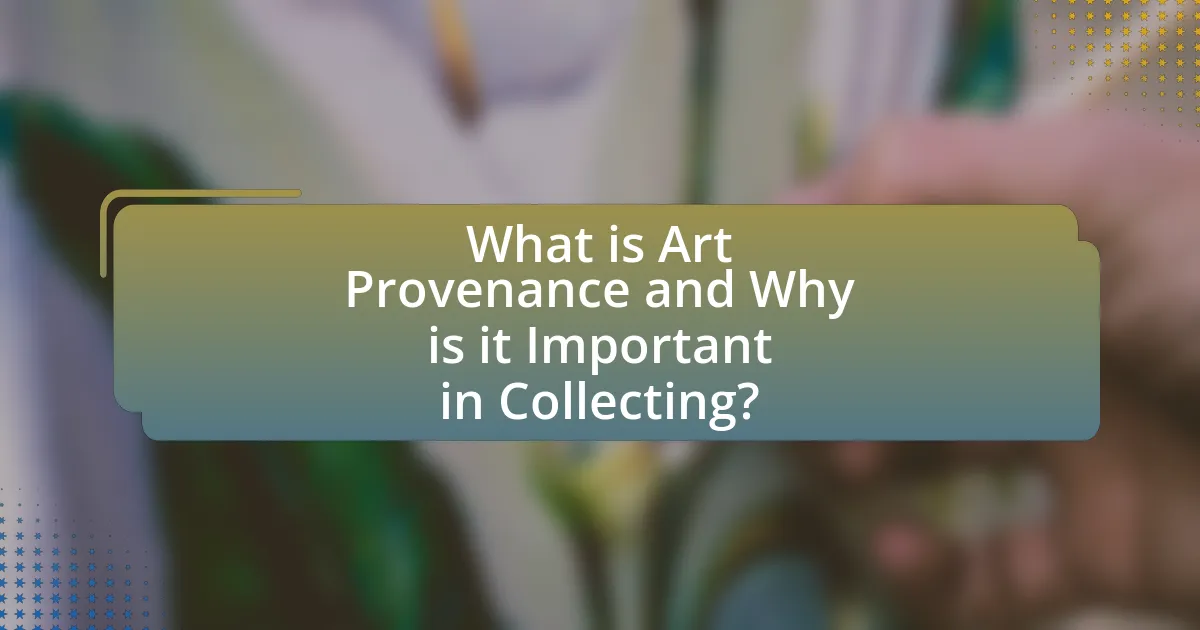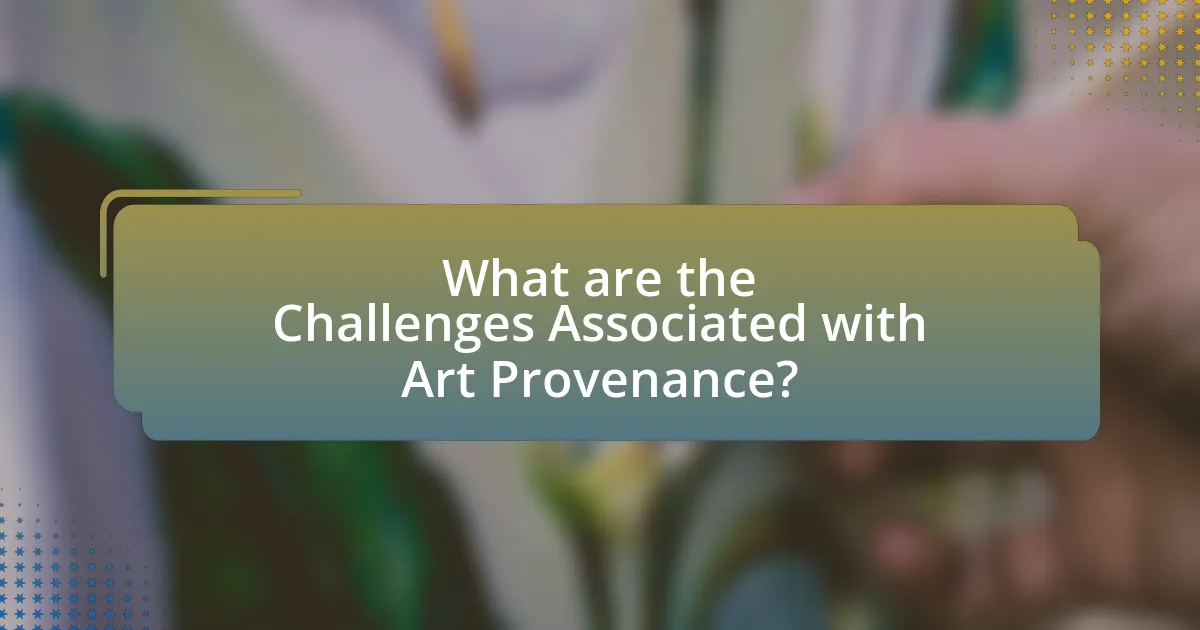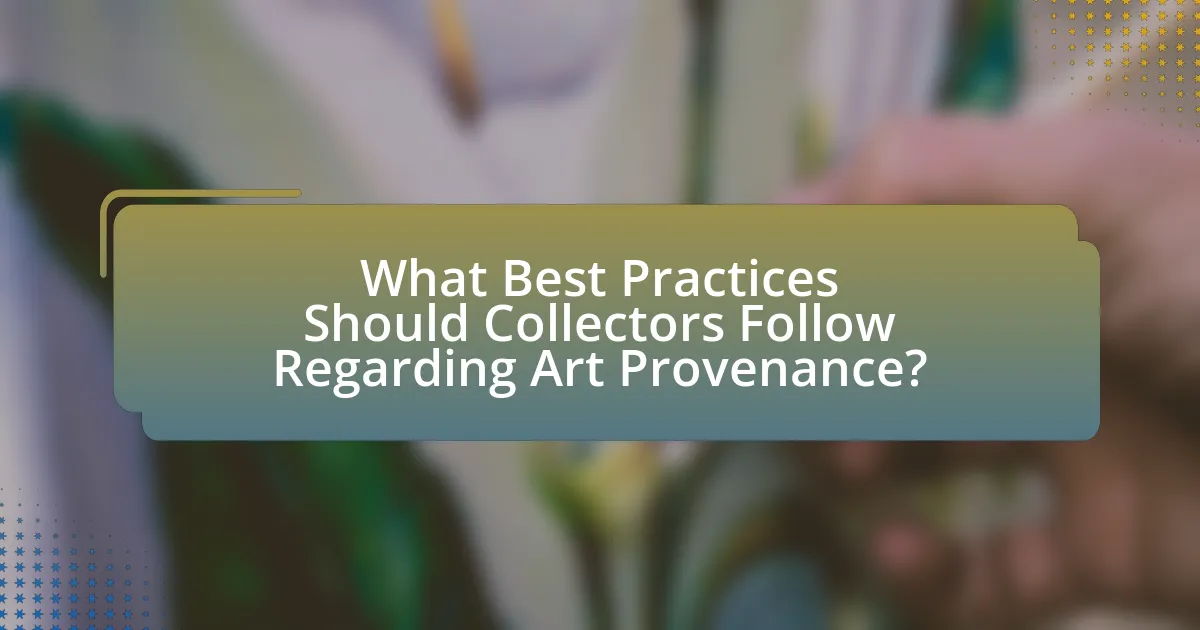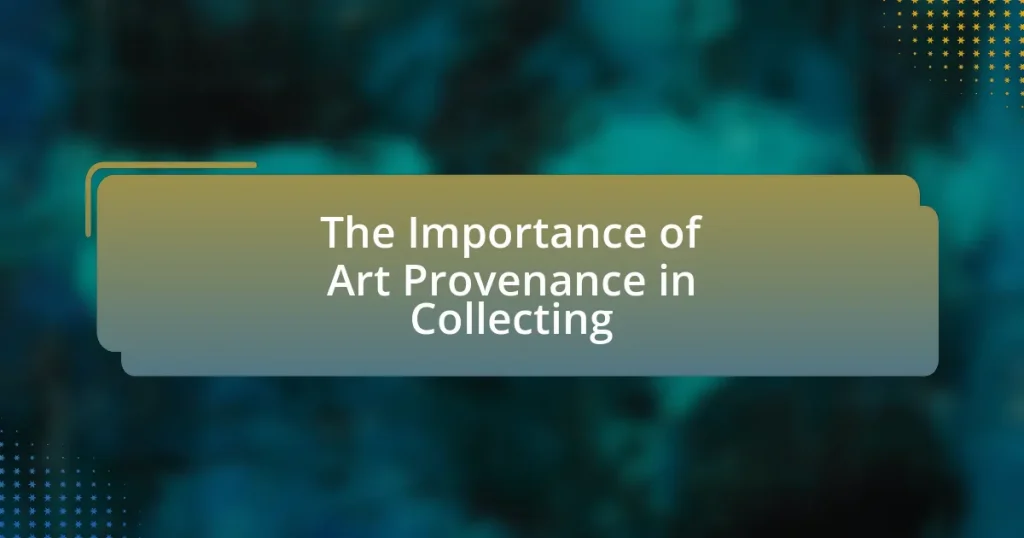Art provenance is the documented history of ownership of a work of art, encompassing its origins, previous owners, and transactions. This information is vital for collectors as it establishes authenticity, prevents fraud, and can significantly enhance the artwork’s market value. The article explores how provenance influences the value and marketability of artworks, the methods for verifying provenance, and the ethical implications of collecting art with clear provenance. Additionally, it addresses the challenges collectors face in tracing provenance and offers best practices for maintaining accurate documentation to ensure the legitimacy and value of their collections.

What is Art Provenance and Why is it Important in Collecting?
Art provenance refers to the history of ownership of a work of art, detailing its origins, previous owners, and any transactions that have occurred. This information is crucial in collecting because it establishes the authenticity and legitimacy of the artwork, helping to prevent fraud and ensuring that collectors are investing in genuine pieces. Provenance can also enhance the artwork’s value; for example, works with a well-documented history, particularly those linked to notable collectors or exhibitions, often command higher prices in the market. Additionally, provenance can provide insights into the cultural and historical context of the artwork, enriching the collector’s understanding and appreciation of the piece.
How does art provenance influence the value of a piece?
Art provenance significantly influences the value of a piece by establishing its authenticity, ownership history, and cultural significance. Provenance provides a documented lineage that can confirm an artwork’s legitimacy, which is crucial in a market where forgeries and misattributions are prevalent. For instance, a painting with a well-documented history, such as ownership by a renowned collector or exhibition in prestigious galleries, can command higher prices due to its perceived value and trustworthiness. Additionally, artworks with provenance linked to historical events or notable figures often appreciate in value, as seen with pieces previously owned by influential personalities, which adds a narrative that enhances desirability among collectors.
What factors contribute to the historical significance of art provenance?
Art provenance is historically significant due to its role in establishing authenticity, ownership history, and cultural context. Authenticity is crucial as it verifies that an artwork is genuine and not a forgery, which is supported by documentation such as certificates of authenticity and expert appraisals. Ownership history, or the chain of custody, provides insights into the artwork’s journey through time, revealing its previous owners, which can enhance its value and importance. Cultural context is also vital, as provenance can illuminate the social, political, and economic conditions surrounding the creation and sale of the artwork, thereby enriching its historical narrative. For instance, artworks that have passed through notable collections or have been associated with significant historical events often carry greater historical weight, influencing their interpretation and appreciation in the art market.
How does provenance affect the marketability of artworks?
Provenance significantly enhances the marketability of artworks by establishing their authenticity and historical significance. When artworks have a well-documented provenance, potential buyers are more likely to trust their legitimacy, which can lead to higher demand and prices. For instance, artworks with a clear chain of ownership, especially those linked to renowned collectors or exhibitions, often command premium prices at auctions. According to a study by the Art Market Research, artworks with verified provenance can sell for up to 50% more than those without, illustrating the direct correlation between provenance and market value.
What role does provenance play in establishing authenticity?
Provenance plays a critical role in establishing authenticity by providing a documented history of an artwork’s ownership and origin. This historical record helps verify that the piece is genuine and not a forgery, as it traces the artwork’s journey from the artist to the current owner. For instance, artworks with well-documented provenance, such as those listed in reputable auction catalogs or museum collections, are more likely to be considered authentic. Provenance can also reveal the context in which the artwork was created, further supporting its legitimacy. In the art market, pieces with clear provenance often command higher prices, as buyers seek assurance of authenticity backed by reliable documentation.
How can provenance documentation prevent art fraud?
Provenance documentation can prevent art fraud by providing a verified history of ownership and authenticity for artworks. This documentation includes records of previous owners, sales, and exhibitions, which can be cross-referenced to confirm the legitimacy of the piece. For instance, a study by the International Foundation for Art Research highlights that artworks with clear provenance are significantly less likely to be disputed or deemed fraudulent, as they can be traced back to reputable sources. By establishing a transparent chain of custody, provenance documentation acts as a deterrent against forgery and misrepresentation in the art market.
What are the common methods for verifying provenance?
Common methods for verifying provenance include documentation review, expert authentication, and scientific analysis. Documentation review involves examining historical records, invoices, and exhibition catalogs to trace the ownership history of an artwork. Expert authentication relies on the assessment of specialists who evaluate the artwork’s style, technique, and materials to confirm its origin. Scientific analysis employs techniques such as carbon dating, pigment analysis, and infrared reflectography to provide objective data supporting the artwork’s authenticity and provenance. These methods collectively enhance the reliability of provenance verification in the art market.
Why is provenance crucial for ethical collecting practices?
Provenance is crucial for ethical collecting practices because it establishes the history and legitimacy of an artwork or artifact. This documentation helps to ensure that items have not been acquired through illegal means, such as theft or looting, which is particularly significant in the context of cultural heritage. Provenance records can trace ownership back to the original creator or rightful owner, thereby supporting claims of authenticity and legal ownership. For instance, the 1970 UNESCO Convention emphasizes the importance of provenance in preventing the illicit trade of cultural property, highlighting its role in protecting cultural heritage and promoting ethical standards in collecting.
How does provenance relate to cultural heritage and ownership rights?
Provenance directly relates to cultural heritage and ownership rights by establishing the history of an artwork or artifact, which is crucial for determining its rightful ownership and cultural significance. Provenance provides documentation that traces an object’s origin, ownership, and transfer through time, thereby validating its authenticity and cultural context. For example, artworks with well-documented provenance can help clarify rightful ownership, especially in cases involving looted or stolen items, as seen in the restitution of artworks taken during World War II. This historical context not only supports claims of ownership but also reinforces the cultural heritage associated with the object, as it reflects the narratives and identities of communities.
What are the implications of lacking provenance in art transactions?
Lacking provenance in art transactions leads to significant risks, including decreased value, increased potential for fraud, and legal complications. Without documented history, artworks may be deemed less desirable, as collectors and investors often seek assurance of authenticity and ownership. For instance, a study by the Art Loss Register indicates that artworks without clear provenance are more likely to be associated with theft or forgery, which can result in legal disputes over rightful ownership. Additionally, the absence of provenance can hinder the ability to sell or insure the artwork, as buyers may be reluctant to invest in pieces with uncertain backgrounds.
How can collectors effectively research art provenance?
Collectors can effectively research art provenance by utilizing a combination of historical documentation, expert consultations, and digital databases. Historical documentation includes examining auction catalogs, exhibition records, and previous ownership details, which provide a timeline of the artwork’s history. Expert consultations involve engaging with art historians, appraisers, and provenance researchers who can offer insights and verify claims regarding the artwork’s background. Digital databases, such as the Art Loss Register and various museum archives, allow collectors to access comprehensive records and databases that track ownership and authenticity. This multi-faceted approach ensures that collectors gather accurate and reliable information about the provenance of the artwork, thereby enhancing their understanding and confidence in their acquisitions.
What resources are available for verifying art provenance?
Resources available for verifying art provenance include databases, auction house records, and scholarly publications. Databases such as ArtNet and Artnet Price Database provide historical sales data and provenance information. Auction houses like Sotheby’s and Christie’s maintain detailed records of past sales, including provenance details for artworks. Scholarly publications and exhibition catalogs often document the history of artworks, providing essential provenance information. Additionally, organizations like the International Foundation for Art Research (IFAR) offer resources and expertise in provenance research, helping collectors verify the authenticity and history of artworks.

What are the Challenges Associated with Art Provenance?
The challenges associated with art provenance include the difficulty in establishing a clear and verifiable history of ownership, the potential for forgery, and the lack of standardized documentation practices. Establishing provenance often requires extensive research into historical records, which can be incomplete or lost, making it hard to trace an artwork’s journey through time. Additionally, the art market has seen instances of forged documents that misrepresent an artwork’s history, complicating the verification process. Furthermore, the absence of universally accepted standards for documenting provenance can lead to inconsistencies and disputes among collectors, galleries, and institutions. These factors collectively hinder the ability to ensure authenticity and rightful ownership in the art world.
What difficulties do collectors face in tracing provenance?
Collectors face significant difficulties in tracing provenance due to incomplete documentation and the lack of standardized record-keeping practices. Many artworks have changed hands multiple times, often without proper records, making it challenging to establish a clear ownership history. Additionally, artworks may have been lost during conflicts or natural disasters, further complicating provenance research. The art market’s reliance on informal transactions and private sales often results in gaps in documentation, which can lead to disputes over authenticity and ownership. Furthermore, the rise of forgeries and fraudulent claims adds another layer of complexity, as collectors must navigate the risk of acquiring pieces with dubious provenance.
How can gaps in provenance history affect a collector’s decision?
Gaps in provenance history can significantly impact a collector’s decision by raising concerns about authenticity and ownership. When a collector encounters missing information regarding an artwork’s previous owners or its journey through the market, it creates uncertainty about its legitimacy. This uncertainty can lead to a decreased willingness to invest in the piece, as collectors often prioritize verified provenance to ensure they are acquiring genuine works. For instance, a study by the Art Loss Register indicates that artworks with incomplete provenance are 50% more likely to be considered forgeries or stolen property. Therefore, gaps in provenance history can deter collectors from making purchases, as they seek to avoid potential legal issues and financial losses associated with acquiring disputed or illegitimate artworks.
What are the legal challenges related to art provenance?
Legal challenges related to art provenance include issues of ownership disputes, authenticity verification, and compliance with international laws regarding cultural property. Ownership disputes arise when multiple parties claim rights to a piece of art, often due to unclear or incomplete provenance records. Authenticity verification is crucial, as artworks may be misattributed or forged, leading to legal ramifications for collectors and dealers. Compliance with international laws, such as the UNESCO Convention, poses challenges when artworks are found to have been illegally exported or looted, potentially resulting in restitution claims. These challenges highlight the necessity for thorough provenance research to mitigate legal risks in art collecting.
How do changes in ownership impact provenance records?
Changes in ownership significantly impact provenance records by altering the documented history of an artwork or artifact. Each transfer of ownership must be accurately recorded to maintain the integrity of provenance, as gaps or inaccuracies can lead to questions about authenticity and legal title. Provenance records serve as a chain of custody, and when ownership changes, it is essential to update these records to reflect the new owner, the date of transfer, and any relevant details about the transaction. For example, the sale of a painting at auction requires thorough documentation to ensure that the new owner can prove legitimate ownership and that the artwork is not stolen or misattributed. This meticulous record-keeping is crucial in the art market, where provenance can significantly affect an artwork’s value and marketability.
What are the best practices for maintaining accurate provenance documentation?
The best practices for maintaining accurate provenance documentation include thorough record-keeping, consistent updates, and verification of information. Thorough record-keeping involves documenting every transaction, ownership change, and exhibition history related to the artwork, ensuring that all details are captured accurately. Consistent updates are crucial as they allow for the incorporation of new information or corrections, which helps maintain the integrity of the provenance record. Verification of information through reliable sources, such as auction house records, gallery documentation, and expert appraisals, ensures that the provenance is credible and trustworthy. These practices are essential for establishing the authenticity and value of artworks, as evidenced by the increasing reliance on provenance in art market transactions and legal disputes.
How can collectors navigate disputes over provenance claims?
Collectors can navigate disputes over provenance claims by conducting thorough due diligence and maintaining comprehensive documentation of the artwork’s history. This includes verifying the authenticity of provenance records, consulting with experts in art history and legal matters, and utilizing resources such as provenance databases and auction house records. Provenance disputes often arise from unclear ownership histories or misrepresented information, making it essential for collectors to gather credible evidence, such as invoices, certificates of authenticity, and previous ownership details. Engaging legal counsel experienced in art law can also provide guidance on resolving disputes effectively, ensuring that collectors are informed of their rights and obligations.

What Best Practices Should Collectors Follow Regarding Art Provenance?
Collectors should ensure thorough documentation of art provenance by maintaining detailed records of ownership history, exhibition details, and any relevant certificates of authenticity. This practice is crucial as it establishes the legitimacy and value of the artwork, helping to prevent issues related to theft or forgery. Provenance documentation can include invoices, gallery labels, and previous auction records, which serve as proof of the artwork’s history. According to a report by the International Foundation for Art Research, artworks with clear provenance are significantly more valuable and easier to sell, underscoring the importance of these best practices in art collecting.
How can collectors ensure they are acquiring artworks with clear provenance?
Collectors can ensure they are acquiring artworks with clear provenance by conducting thorough research on the artwork’s history and ownership. This involves obtaining documentation such as certificates of authenticity, exhibition records, and previous sales receipts that trace the artwork’s lineage. Provenance research can also include consulting databases and registries that track artworks, as well as engaging with reputable galleries and auction houses that provide detailed provenance information. According to a report by the Art Loss Register, artworks with documented provenance are less likely to be subject to disputes or claims of theft, reinforcing the importance of verifying provenance before purchase.
What steps should be taken before purchasing an artwork?
Before purchasing an artwork, it is essential to verify its provenance, which refers to the history of ownership and authenticity of the piece. This step ensures that the artwork is genuine and not stolen or forged, as artworks with clear provenance often have higher value and are more desirable to collectors. Additionally, potential buyers should conduct thorough research on the artist, including their background, market value, and previous sales, to assess the investment potential. Consulting with art experts or appraisers can provide further validation of the artwork’s authenticity and value. Finally, reviewing any available documentation, such as certificates of authenticity or previous sale records, is crucial to confirm the artwork’s legitimacy and history.
How can collectors build a reliable provenance database?
Collectors can build a reliable provenance database by systematically documenting the ownership history of each artwork, including details such as previous owners, sales records, and exhibition history. This process involves gathering and verifying information from credible sources like auction houses, galleries, and museums, which often maintain detailed records of transactions and exhibitions. Additionally, collectors should utilize digital tools and databases that specialize in art provenance, such as the Art Loss Register, which helps track stolen or missing artworks. By ensuring that all entries are accurate and sourced from reputable documentation, collectors can create a trustworthy provenance database that enhances the value and authenticity of their collections.
What are the benefits of maintaining thorough provenance records?
Maintaining thorough provenance records provides several key benefits, including enhanced authenticity verification, increased market value, and legal protection. Provenance records establish a documented history of an artwork’s ownership, which helps to confirm its authenticity and origin, thereby reducing the risk of fraud. For instance, artworks with well-documented provenance often command higher prices at auction; a study by the Art Market Research found that artworks with clear provenance can sell for up to 50% more than those without. Additionally, thorough records can protect collectors legally by providing evidence of rightful ownership, which is crucial in disputes or claims of theft.
How does good provenance documentation enhance resale value?
Good provenance documentation enhances resale value by providing verified history and authenticity of an artwork. This documentation assures potential buyers of the piece’s legitimacy, reducing the risk of fraud and increasing buyer confidence. For instance, artworks with well-documented provenance often command higher prices at auctions; a study by Artprice found that pieces with clear provenance sold for up to 50% more than those without. Thus, good provenance not only establishes trust but also significantly impacts the financial worth of art in the resale market.
What role does provenance play in insurance and estate planning?
Provenance plays a critical role in insurance and estate planning by establishing the ownership history and authenticity of artworks, which directly impacts their valuation and insurability. Accurate provenance documentation can significantly enhance an artwork’s market value, as collectors and insurers rely on verified histories to assess risk and determine premiums. For instance, artworks with well-documented provenance are often insured at higher values due to their established legitimacy and reduced risk of forgery. Additionally, in estate planning, clear provenance helps ensure that artworks are distributed according to the deceased’s wishes, minimizing disputes among heirs and facilitating smoother transitions of ownership.
What practical tips can collectors use to enhance their understanding of art provenance?
Collectors can enhance their understanding of art provenance by conducting thorough research on the artwork’s history, including previous ownership, exhibition records, and sales transactions. This involves utilizing resources such as auction house archives, gallery records, and databases like ArtNet or the Art Loss Register, which provide detailed information on artworks and their provenance. Additionally, engaging with art historians or provenance researchers can offer expert insights into the significance of the artwork’s history. Collectors should also verify the authenticity of provenance documents and seek out certificates of authenticity from reputable sources, as these can substantiate the claims regarding the artwork’s history.















